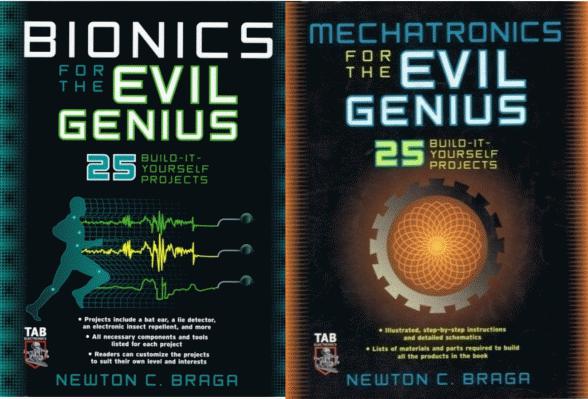The books Mechatronics for the Evil Genius and Bionics for the Evil Genius are part of a great hit series by TAB.

In fact, what we call Evil Genius is not really an evil young man as we might think, but rather that genius who likes to use his knowledge (most of the time even beyond the adults themselves) to play tricks or pranks not always very ethical, although they are not really dangerous.
Of course, it is also included in the ample hall of things which can be done interesting projects that aim to leave friends of the "evil genius" surprised and even adults.
This series features many books which can be purchased in the English version on Amazon (for example) at https://www.amazon.com/Dangerously-Mad-Projects-Evil-Genius/dp/0071755675/ref=sr_1_1?s = books & ie = UTF8 & qid = 1508786287 & sr = 1-1 & keywords = evil + genius + series

But the fact is, the growing interest in practical assemblies by STEMers, who are technology students, and the rise of topics such as bionics, make our two books successful.
In the figure below we have the old Russian and Chinese editions made in 2006 and 2007.

We have recently received new Chinese editions for the Mechatronics for the Evil Genius and Bionics for the Evil genius with a better format of the same type used in the United States.
The cover of the Chinese editions is in the figure below.

Although the books are somewhat old, the content is still very current in many points.
For example, in the book Bionics for the Evil Genius we describe the Panic Circuit which makes real the possibility of making a sonic attack, of course not in the same dimensions of what happened in Cuba.
However, the idea is widely explored with a simple (not powerful) practical circuit. Other important projects like the use of electric fish to monitor water, are also in this book.
For Mechatronics for the Evil Genius we have designs which nowadays can be easily updated with the use of microcontrollers, the same occurring in relation to the previous one.
Most of the content in these books comes from projects I set up with my students, so the photos that appear on them show that the projects have actually been assembled.
Readers who follow the sites in Spanish and English can also find many articles from these books and others based on the work we did with our students at the time.
With electronics increasingly joining other sciences like biology, bionic designs are on the rise and many of them must be joined to mechatronics. All this shows that our visionary work from before 2006, leading to the books that came out from this era, is still recognized.



